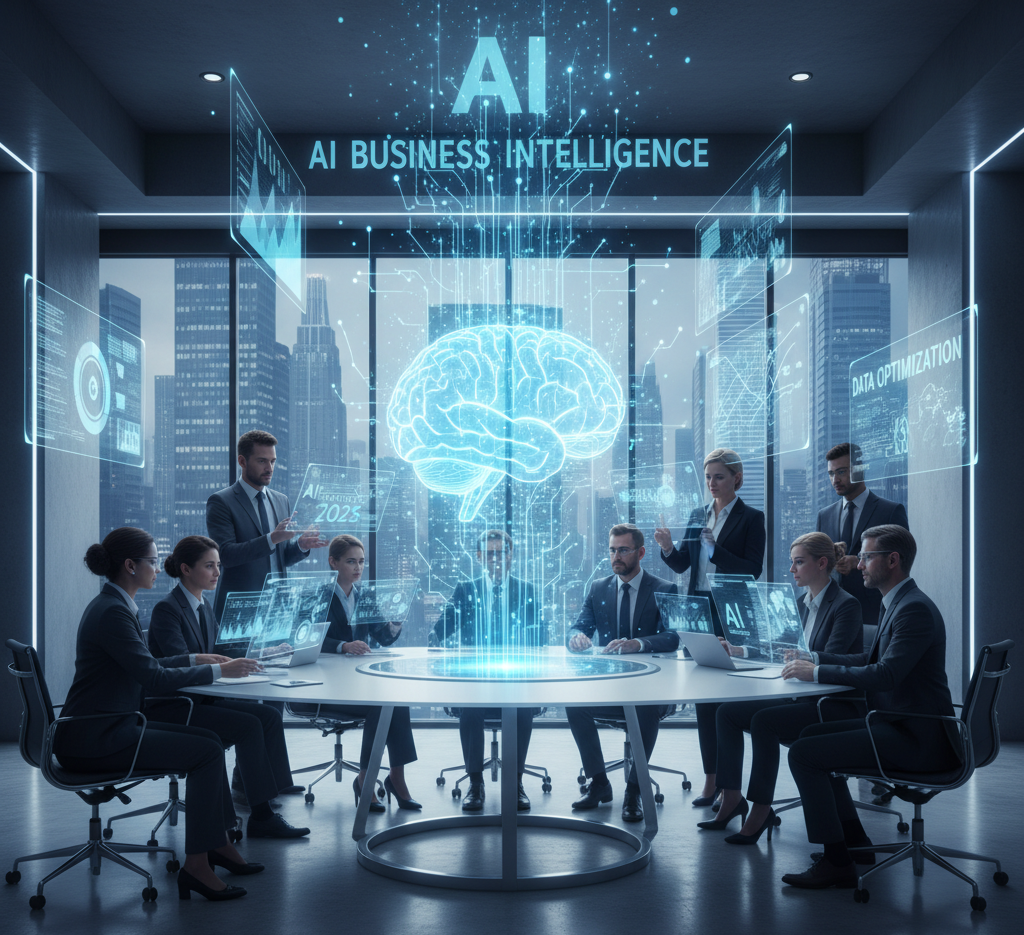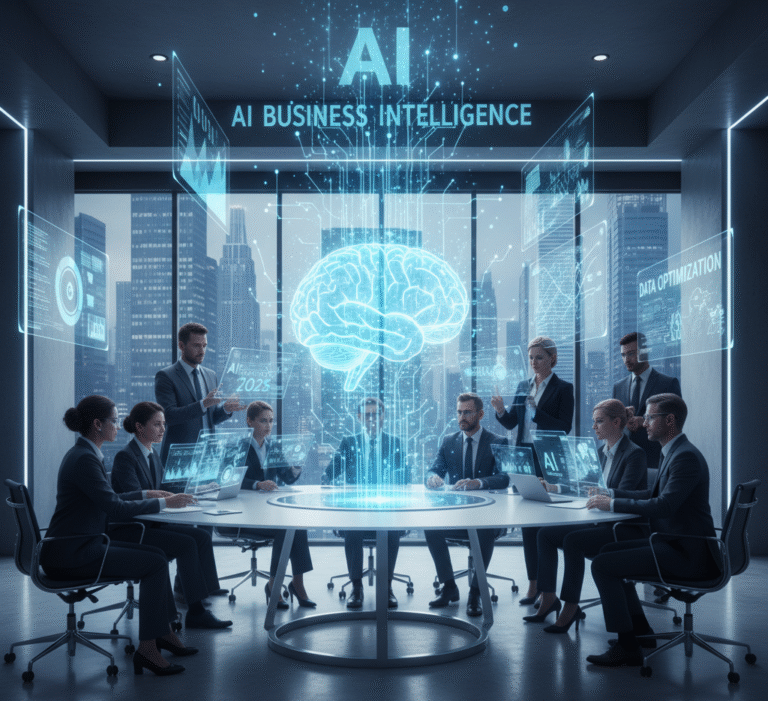AI in Business 2025: How Artificial Intelligence Is Transforming Companies and Driving Growth

AI in Business – where smart technology meets smart strategy.
💼 AI in Business 2025: How Artificial Intelligence Is Transforming Companies and Driving Growth
🌐 Introduction: The Age of AI-Driven Businesses
Artificial Intelligence (AI) is no longer science fiction — it’s the foundation of modern business success.
From customer service chatbots and predictive analytics to automated marketing and smart decision-making systems, AI has become the core engine of innovation across industries.
In 2025, companies that adopt AI aren’t just improving efficiency — they’re redefining competition.
So, what is AI in business, how does it work, and how can you implement it effectively?
Let’s explore everything you need to know.
🤖 1. What Is AI in Business?
AI in business refers to the use of artificial intelligence technologies — such as machine learning, natural language processing, computer vision, and data analytics — to automate processes, analyze big data, and support decision-making.
In simple terms:
AI in Business helps businesses work smarter, faster, and more efficiently by learning from data.
✨ Example:
-
Netflix uses AI to recommend shows based on your viewing habits.
-
Amazon uses AI for inventory management and personalized shopping.
-
Banks use AI to detect fraud in real-time.
💡 2. Why Matters for AI in Business 2025
By 2025, AI is expected to add over $15 trillion to the global economy.
Companies that integrate AI early gain a competitive edge by:
-
Automating repetitive tasks
-
Enhancing customer experience
-
Improving data-driven decisions
-
Reducing operational costs
-
Increasing innovation speed
📈 Real-World Impact:
-
80% of business executives say AI helps them gain or sustain a competitive advantage.
-
60% of companies plan to integrate AI in at least one business function by the end of 2025.
🧩 3. How to used AI in Business?
AI applications vary across industries. Here are the top ways companies use AI today:
🧭 3.1 Customer Support Automation
AI chatbots and virtual assistants like ChatGPT, Zendesk AI, and Intercom handle customer queries 24/7 — improving satisfaction while cutting costs.
🛒 3.2 Marketing & Sales
AI tools analyze customer behavior and predict buying intent.
Examples:
-
HubSpot AI predicts leads most likely to convert.
-
Google Ads uses AI for automated bidding.
-
Copy.ai generates ad content in seconds.
🏭 3.3 Manufacturing & Operations
AI improves supply chain efficiency and quality control.
Examples:
-
Predictive maintenance reduces downtime.
-
Robots powered by AI handle precision assembly.
💳 3.4 Finance & Banking
AI helps detect fraud, manage risks, and personalize investment advice.
Examples:
-
JPMorgan uses AI to analyze contracts faster.
-
PayPal uses machine learning for transaction monitoring.
🏥 3.5 Healthcare
AI assists in diagnostics, treatment planning, and medical imaging.
Examples:
-
AI algorithms detect early-stage diseases.
-
Chatbots guide patients toward proper care.
🏠 3.6 Real Estate & Retail
AI evaluates property values, predicts trends, and personalizes shopping experiences.
Examples:
-
Zillow uses AI for price predictions.
-
Amazon uses AI-driven product recommendations.
🧱 4. How to Implement AI in Business (Step-by-Step)
Implementing AI is not just about adopting technology — it’s about building an AI strategy.
Here’s a 7-step guide to help you get started:
Step 1: Identify Business Problems
List tasks that are repetitive, data-heavy, or decision-based — perfect for AI automation.
👉 Example: customer service, demand forecasting, or content generation.
Step 2: Set Clear Goals
Define what success looks like — e.g., “reduce customer service costs by 30%” or “increase sales conversions.”
Step 3: Collect and Clean Data
AI systems learn from data. Ensure your data is accurate, complete, and structured.
Step 4: Choose the Right AI Tools
Depending on your needs:
-
Marketing: Jasper, HubSpot AI, ClickUp Brain
-
Customer Service: ChatGPT API, Drift, Tidio
-
Analytics: Tableau, Power BI, IBM Watson
-
Operations: UiPath, Zapier, Salesforce Einstein
Step 5: Train Your Team
Employees must understand how to use AI systems and interpret data insights. Offer workshops or certifications.
Step 6: Integrate and Test
Start small with pilot projects, analyze results, and scale gradually.
Step 7: Monitor and Improve
AI models evolve — keep refining algorithms to match new trends and data.
⚙️ 5. Benefits of Using AI in Business
AI provides tangible results across every department. Here’s what you can expect:
| Business Area | AI Application | Benefit |
|---|---|---|
| Marketing | Predictive analytics | Better targeting |
| HR | Resume screening bots | Faster hiring |
| Customer Service | Chatbots | 24/7 support |
| Finance | Fraud detection | Fewer losses |
| Operations | Process automation | Increased efficiency |
| Sales | AI recommendations | Higher conversions |
📊 6. Challenges in Implementing AI
AI brings huge advantages — but it’s not plug-and-play.
🔸 Data Privacy & Security
AI needs data, and protecting that data is vital.
🔸 High Initial Cost
Developing AI infrastructure can be expensive at first.
🔸 Skill Gap
Not every employee understands AI; training is crucial.
🔸 Ethical Concerns
AI bias, deepfakes, and misuse need regulation.
General AI Tools 2025: Transforming Business, Creativity & Research
The AI revolution continues to reshape industries in 2025. From business automation, content generation, marketing, SEO, to creative arts and scientific research, AI tools are becoming indispensable. This guide explores the best AI tools and platforms for businesses, creators, researchers, and developers.
🧬 7. Future of AI in Business (2025 and Beyond)
The AI revolution is just beginning.
Here’s what’s coming next:
-
AI Agents: Businesses will rely on autonomous AI systems for planning, marketing, and customer service.
-
Hyper-Personalization: Every customer experience will be tailored using behavioral AI.
-
AI + IoT: Smart factories and logistics powered by AI sensors.
-
Generative AI: AI-created designs, emails, and ads.
-
AI Governance: Ethical frameworks for responsible AI use.
By 2030, nearly 90% of companies will use AI for core business operations.
💬 8. Real-Life Examples of AI in Business
📱 Example 1: Coca-Cola
Uses AI for predicting beverage trends and optimizing supply chains.
🛍 Example 2: Sephora
AI-powered app gives personalized beauty recommendations.
💳 Example 3: Mastercard
AI detects fraudulent transactions instantly.
🏦 Example 4: JPMorgan Chase
AI reviews thousands of legal contracts in seconds — saving over 360,000 work hours per year.
📘 9. How Small Businesses Can Start Using AI
AI isn’t just for tech giants — startups and small businesses can benefit too.
Here’s how:
-
Use AI chatbots (Tidio, Intercom) for customer support.
-
Use AI marketing tools (Mailchimp AI, Jasper) for content automation.
-
Analyze data using Power BI or Google Analytics AI insights.
-
Implement voice search optimization.
-
Use AI-powered CRMs like HubSpot or Zoho.
🧭 10. Conclusion: The Future Is AI-Driven
AI is no longer optional — it’s the new operating system of modern business.
Companies that understand, adopt, and optimize AI today will dominate tomorrow’s market.
Start small. Think strategically.
Because the question is no longer “Should we use AI?” — it’s “How fast can we adapt?”



